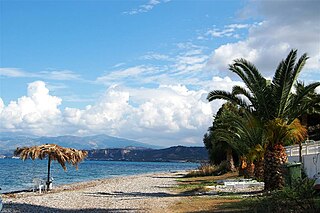Related Research Articles

William of Villehardouin was the fourth prince of Achaea in Frankish Greece, from 1246 to 1278. The younger son of Prince Geoffrey I, he held the Barony of Kalamata in fief during the reign of his elder brother Geoffrey II. William ruled Achaea as regent for his brother during Geoffrey's military campaigns against the Greeks of Nicaea, who were the principal enemies of his overlord, the Latin Emperor of Constantinople Baldwin II. William succeeded his childless brother in the summer of 1246. Conflicts between Nicaea and Epirus enabled him to complete the conquest of the Morea in about three years. He captured Monemvasia and built three new fortresses, forcing two previously autonomous tribes, the Tzakones and Melingoi, into submission. He participated in the unsuccessful Egyptian crusade of Louis IX of France, who rewarded him with the right to issue currency in the style of French royal coins.

Alissos is a village and a community in the municipal unit of Dymi, Achaea, Greece. It is located near the Gulf of Patras, 3 km east of Kato Achaia, 3 km southwest of Kaminia and 17 km southwest of Patras. The community consists of the villages Alissos, Kamenitsa, Paralia Alissou and Profitis Elissaios. The Greek National Road 9 and the railway from Patras to Pyrgos run between Alissos and Paralia Alissou.

The Villehardouin family was a noble dynasty that originated in Villehardouin, a former commune of the Aube department, now part of Val-d'Auzon, France. It is most notable as the ruling house of the Principality of Achaea, a Frankish crusader state in the Peloponnese peninsula of Greece, between 1209 and 1278, when possession passed to the Angevin Kings of Naples.
George I Ghisi was a Latin feudal lord in medieval Greece.

John of Saint Omer was baron of a third of Akova and marshal of the Principality of Achaea.

The Barony of Vostitsa was a medieval Frankish fiefdom of the Principality of Achaea, located in the northern coast of the Peloponnese peninsula in Greece, centred on the town of Vostitsa.

The Barony of Akova was a medieval Frankish fiefdom of the Principality of Achaea, located in the mountains of eastern Elis in the Peloponnese peninsula in Greece, centred on the fortress of Akova or Mattegrifon. It was among the twelve original baronies of Achaea, but was conquered by the Byzantines in 1320.

The Barony of Passavant or Passava was a medieval Frankish fiefdom of the Principality of Achaea, located in the mountains between the Mani peninsula and the plain of Laconia, in the Peloponnese peninsula in Greece, centred on the fortress of Passavant or Passava. It was among the twelve original baronies of the Principality of Achaea, but was conquered by the Byzantines in the early 1260s.

The Barony of Kalavryta was a medieval Frankish fiefdom of the Principality of Achaea, located in the Peloponnese peninsula in Greece, centred on the town of Kalavryta.

The Barony of Karytaina or of Skorta was a medieval Frankish fiefdom of the Principality of Achaea, located in the Peloponnese peninsula in Greece, centred on the town of Karytaina in the mountainous region known as Skorta.

The Barony of Chalandritsa was a medieval Frankish fiefdom of the Principality of Achaea, located in the northern Peloponnese peninsula in Greece, and centred on the town of Chalandritsa south of Patras.
Guy (II) of Dramelay was the third Baron of Chalandritsa in the Principality of Achaea in Frankish Greece, and also bailli of the Principality in 1282–85.
Geoffrey of Briel, in older literature Geoffrey of Bruyères, was a French knight and the third lord of the Barony of Karytaina in the Principality of Achaea, in Frankish Greece. He led a colourful and turbulent life, narrated in detail in the Chronicle of the Morea. Accounted the finest knight in the Principality, he fought in the wars against the Byzantine Greeks, was captured in the Battle of Pelagonia in 1259, and was sent back to Achaea bearing the Byzantine terms in 1261. Geoffrey was twice deprived of his barony, once for rebelling against his uncle, the Prince of Achaea William II of Villehardouin, and then for abandoning the Principality without leave in order to spend time with a mistress, the wife of one of his feudatories, in Italy. He was pardoned both times, but henceforth held his title as a gift of the Prince. He died childless in 1275, and the Barony of Karytaina was split up.

The Barony of Veligosti or Veligosti–Damala was a medieval Frankish fiefdom of the Principality of Achaea, originally centred on Veligosti in southern Arcadia, but also came to include the area of Damala in the Argolid when it came under a cadet branch of the de la Roche family in the 1250s. After Veligosti was lost to the Byzantines towards 1300, the name was retained even though the barony was reduced to Damala.
William de la Roche was a Baron of Veligosti and Damala in the Principality of Achaea, and a relative of the ruling Dukes of Athens of the de la Roche family.
Margaret of Villehardouin was the daughter of William II of Villehardouin, Prince of Achaea, and his third wife Anna Komnene Doukaina.
Geoffrey II of Briel or Geoffrey of Briel the Younger, was a French knight and the cousin or nephew of Geoffrey I of Briel, Baron of Karytaina in the Principality of Achaea, in Frankish Greece.
Margaret of Nully also known as Margaret of Passavant, was the hereditary Lady of Passavant, Akova and Mitopoli in the Principality of Achaea, in Frankish Greece.
John of Nully was a French knight from Nully became the first Baron of Passavant in the Principality of Achaea. The date of his death is unknown.
Geoffrey of Aulnay was Baron of Arcadia in the Principality of Achaea in the late 13th century.